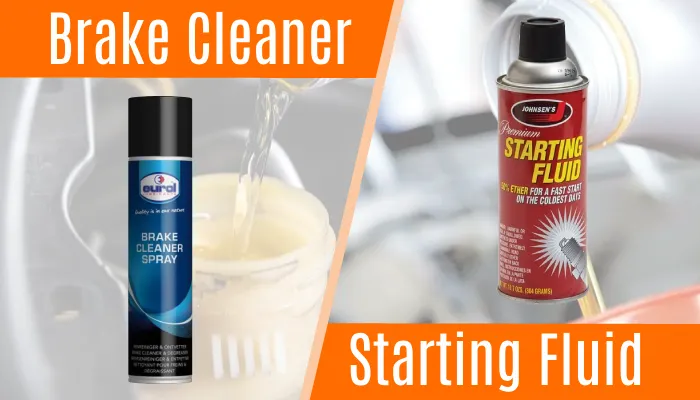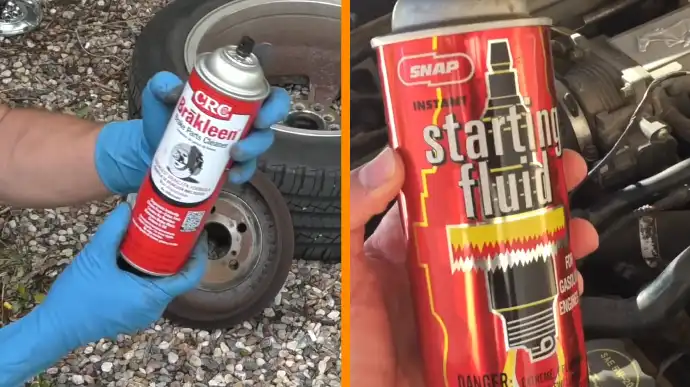Physical Address
304 North Cardinal St.
Dorchester Center, MA 02124
Physical Address
304 North Cardinal St.
Dorchester Center, MA 02124

Brake cleaner and starting fluid are two essential products in automotive maintenance. Although they might look similar, both brake cleaner and starting fluid serve completely different purposes.
Brake cleaner is primarily used to remove oil, grease, and other contaminants from brake components while starting fluid aids in starting internal combustion engines.
The composition of brake cleaner contains a mixture of chemicals like methyl acetate, hydrocarbons, and acetone, effectively removing contaminants from brake parts.
On the other hand, starting fluid primarily consists of volatile hydrocarbons like heptane, diethyl ether, and carbon dioxide, which help ignite engines.
Here we will describe in detail the differences between brake cleaners and starting fluids to familiarize you with their individual uses and applications.

Brake cleaners and starting fluids differ in many categories, so understanding the differences is key to their proper and safe use.
Brake cleaner is composed of a mixture of chemicals, such as methyl acetate, hydrocarbons, and acetone. The specific composition may vary depending on the brand and product.
These chemicals are carefully selected for their ability to efficiently remove oil, grease, and contaminants from brake parts. Some brake cleaner formulations may also include additional components like water and fragrances to enhance performance and user satisfaction.
Conversely, starting fluid has a simpler composition. It is primarily composed of volatile hydrocarbons such as heptane, diethyl ether, and carbon dioxide. Certain formulations may add butane or propane as propellants and starting fuel.
The composition of the starting fluid is designed to facilitate rapid ignition within the engine’s combustion chamber. This method allows engines to be started more easily, particularly when the weather is cold or when traditional starting methods prove ineffective.
Brake cleaner is primarily used in the automotive sector to clean and degrease metal parts associated with braking systems, such as brake linings, drums, cylinders, and related components. It aims to remove oil, grease, brake dust, and contaminants to maintain optimal brake performance.
Conversely, starting fluid serves a completely different purpose. It’s specifically designed to assist in starting internal combustion engines, especially in cold weather or when a vehicle is experiencing difficulty starting.
Starting fluid can be used in various engine types, including gasoline, diesel, two-stroke, and four-stroke engines. This makes it versatile in its applications for vehicles, lawnmowers, chainsaws, outboard motors, and fractional horsepower engines.
For a clear understanding of the distinction between brake cleaner and starting fluid, consider their varying levels of combustibility.
Brake cleaner, although flammable to some extent, isn’t meant for combustion. Its chemical composition doesn’t promote ignition within an engine’s cylinders. Attempting to start an engine using brake cleaner can be risky, as it lacks the necessary fuel-air mixture for ignition.
In contrast, starting fluid is explicitly designed to be combustible. It contains volatile hydrocarbons like heptane and diethyl ether, carefully selected for their ability to facilitate ignition in internal combustion engines. When used correctly, starting fluid promotes the required conditions for rapid and reliable engine ignition.
The contrasting combustibility levels of brake cleaner and starting fluid highlight their distinct purposes and applications.
Brake cleaner is typically a colorless liquid that can be found in various forms, such as liquid spray, aerosol spray, or bulk liquid. Its appearance is designed to be clear or transparent, ensuring that it can be applied to brake parts without leaving behind any visible residue.
Meanwhile, starting fluid also appears as a clear, colorless liquid, but it’s commonly available in aerosol form.
Packaged in pressurized aerosol cans, starting fluid delivers a fine liquid mist, allowing for even dispersion into the engine’s intake system. This aerosol form promotes efficient combustion by ensuring a homogeneous fluid mixture with the air.
To understand the differences between brake cleaner and starting fluid, it’s important to consider their respective vapor pressures. Vapor pressure refers to the pressure exerted by the vapor of a substance at a specific temperature.
Brake cleaner typically has a relatively lower vapor pressure compared to starting fluid. This is due to the brake cleaner’s chemical composition and evaporation rate, which is lower than the starting fluid.
Starting fluid, on the other hand, typically has a higher vapor pressure. This is crucial for its role in engine ignition. The higher vapor pressure ensures that the starting fluid quickly vaporizes and mixes with air, creating the necessary fuel-air mixture for combustion when introduced into the engine’s intake.
Brake cleaner is known for its distinctive odor, which can vary depending on the specific formulation. This odor is often associated with the chemicals used, such as acetone and hydrocarbons.
On the other hand, starting fluid has a unique odor that’s commonly described as ‘ether-like.’ This odor is attributed to the presence of diethyl ether in the starting fluid’s composition.
| Aspect | Brake Cleaner | Starting Fluid |
| Composition | A mix of chemicals, including methyl acetate, hydrocarbons, and acetone, depending on the brand. | Hydrocarbons include heptane, diethyl ether, and carbon dioxide, possibly butane, and propane too. |
| Primary Purpose | Designed to clean and degrease automotive brake components. | Engine ignition assistance, especially in cold weather or challenging starting conditions. |
| Combustibility | Flammable but not intended for combustion | Explicitly designed to be combustible, promoting rapid engine ignition. |
| Appearance and Form | Colorless liquid, available in various forms (liquid spray, aerosol, bulk liquid). | Clear, colorless liquid, typically packaged in aerosol form for even dispersal. |
| Vapor Pressure | May have relatively lower vapor pressure. | Typically has a higher vapor pressure to facilitate rapid vaporization and mixing with air for combustion. |
| Odor | Distinctive odor, varying with product formulations, often associated with acetone and hydrocarbons. | Ether-like odor attributed to the presence of diethyl ether, primarily used for combustion properties. |

You should refrain from using brake cleaner as a replacement for starter fluid. While it may be tempting in emergencies, it’s important to understand the potential risks involved.
Brake cleaner is primarily designed for cleaning brake parts, and its harsh chemical composition can cause harm to the engine. If used as a substitute, it should only be sprayed into the car’s air intake system, specifically the throttle body or carburetor, to assist in starting the engine.
However, you should be aware of the potential side effects. Brake cleaners can corrode metals, damage rubber seals and plastics, and release harmful gasses when burned.
Safer alternatives to starting fluid exist, and it’s essential to follow manufacturer recommendations to prevent potential damage and ensure safety.
Store brake cleaner and starting fluid in a cool and well-ventilated area, away from direct heat sources, open flames, or sparks. These products are highly flammable, so preventing any potential ignition sources is crucial.
Ensure that containers are tightly sealed to avoid evaporation or leakage. For aerosol containers, maintain storage temperatures below 50°C and away from direct heat.
It’s important to store these products out of the reach of children and in a safe location to minimize the risk of accidental exposure.
Brake cleaner effectively removes rust from your car’s metal surfaces. To begin, place a tray underneath the rusted area to catch any runoff. Spray the rusted surface with brake cleaner, ensuring complete coverage. Allow the surface to dry thoroughly before proceeding.
Ensure that your cleaning rag is free from any oil or contaminants. If rust remains, apply more brake cleaner directly to the affected area. Then, use either steel wool or a wire brush to work on the surface, applying gentle pressure in a back-and-forth motion. This will help to remove the rust and restore the metal surfaces of your car.
When considering the use of starting fluid, especially in older cars, it’s important to be aware of its compatibility with your specific vehicle. Starting fluid isn’t suitable for all engines, especially those with glow plugs or that run on diesel fuel.
For older models, in particular, caution is advised. The use of starting fluid can potentially cause damage to sensitive components or lead to engine misfires. It’s recommended to consult your vehicle’s user guide or seek professional advice before using starting fluid on an older engine.
Older engines may have different specifications and requirements, and using starting fluid without proper knowledge can result in costly repairs or even permanent damage to the engine.
Therefore, exercise caution and ensure compatibility before using starting fluid on any engine, especially older models.
It is now clear that brake cleaner and starting fluid, while they may appear similar, have distinct compositions and purposes. Brake cleaner excels in maintaining brake components’ cleanliness, ensuring optimal performance and safety.
In contrast, starting fluid is engineered to aid in starting internal combustion engines under challenging conditions.
You should never use brake cleaner as a substitute for starting fluid, as it has the potential to damage your engine. Always store these products safely, away from heat sources and flames, and out of children’s reach.
When considering the use of starting fluid, especially on older engines, exercise caution and consult your vehicle’s specifications to avoid costly damage. Your vehicle’s health and fitness relies on the appropriate application of these essential maintenance tools.